Are you a Quiet Speculation member?
If not, now is a perfect time to join up! Our powerful tools, breaking-news analysis, and exclusive Discord channel will make sure you stay up to date and ahead of the curve.
A major cycle in Ikoria is that of companions, which are essentially opt-in Commanders for sanctioned constructed formats like our own. If a certain deckbuilding condition is met, companions may be cast once from outside the game. Except there's no Commander Zone in Modern, meaning they'll have to take up a sideboard slot unless they are somehow exiled from the mainboard.
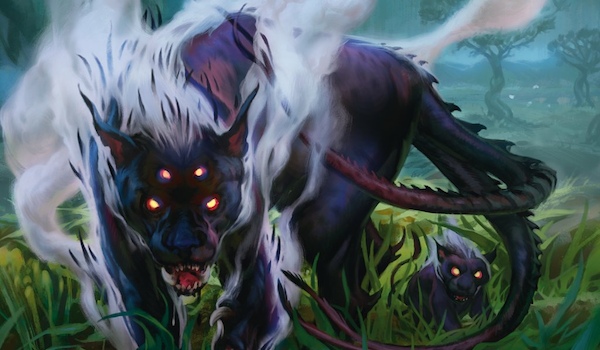
Many of the companions seem to have some niche, owing in large part to the mechanic's novelty—being pre-tutored as well as letting players functionally start each game with an extra card are enormous benefits that will almost always outweigh the lost sideboard card, and every once in a while justify the imposted deckbuilding restriction. I imagine at least five companions will see some degree of play in Modern, even if some seem more destined for the fringe.
Companions: Cost-Benefit Analysis
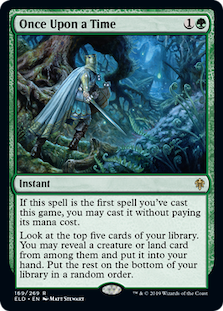 The creatures themselves aren't that jaw-dropping. Rather, I think they'll prove popular because of the strength of companion itself. To understand the gravity of introducing a commander element into other constructed formats, it has helped me to think about the mechanic's costs and benefits.
The creatures themselves aren't that jaw-dropping. Rather, I think they'll prove popular because of the strength of companion itself. To understand the gravity of introducing a commander element into other constructed formats, it has helped me to think about the mechanic's costs and benefits.
Costs
- One sideboard slot. This cost is quite marginal.
- Building around the stated requirement. This one is tougher to dismiss.
Some Modern decks will want unlimited access to a companion's effect bad enough that they warp their construction to fulfill its requirement. But for the most part, I think Modern decks will run companions simply because they already fulfill those requirements, and it's tough to pass on the benefits.
Benefits
- Locked-in tutoring. The companion is cast-able as of the game's outset; there's no need to find it.
- Locked-in card advantage. Not only do players start with a certain card, they start with an extra card at all.
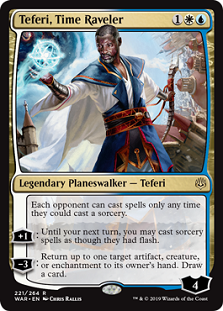 Companions allow Modern players to start every game with an extra card. Since the card never changes, consistency is also added. Have you ever played a friendly game and mulled to five, only to have your buddy allow you to draw back up to seven, only to draw two more blanks and have to mulligan anyway? With companion, the extra card is always the same one, easing requirements of openers in a way we haven't seen since... well, Once Upon a Time.
Companions allow Modern players to start every game with an extra card. Since the card never changes, consistency is also added. Have you ever played a friendly game and mulled to five, only to have your buddy allow you to draw back up to seven, only to draw two more blanks and have to mulligan anyway? With companion, the extra card is always the same one, easing requirements of openers in a way we haven't seen since... well, Once Upon a Time.
Companions cost three or more mana, meaning most of them provide value plans or bursts in the mid-game. In this regard, they're a lot like cheap planeswalkers. Having those plans guaranteed, rather than needing to draw into them at the right time (and not at the wrong time, such as in the first couple turns of a game), is absolutely game-altering.
Meet the Meat
With the preamble out of the way, let's introduce five companions I think are sure to see tabletop action in Modern.
Jegantha, the Wellspring
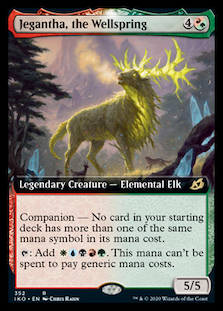 First up is Jegantha, the Wellspring, which already has an obvious home: 5-Color Niv Mizzet. These decks aim to keep opponents at bay with splashy spells until they can resolve their namesake dragon, draw plenty of cards, and leverage their newfound card advantage into a win. Jegantha looks like it will be very comfortable in the sideboard, from where it provides an attractive Plan B in lieu of Niv Mizzet Reborn, or even to bait out countermagic before going for the Dragon.
First up is Jegantha, the Wellspring, which already has an obvious home: 5-Color Niv Mizzet. These decks aim to keep opponents at bay with splashy spells until they can resolve their namesake dragon, draw plenty of cards, and leverage their newfound card advantage into a win. Jegantha looks like it will be very comfortable in the sideboard, from where it provides an attractive Plan B in lieu of Niv Mizzet Reborn, or even to bait out countermagic before going for the Dragon.
Once it's in play, Jegantha threatens opponents in a couple of ways. Most obviously, it's 5/5, which is large enough in Modern to have granted Gurmag Angler premier status as a beater. But more importantly, it taps to create up to five mana, a resource the Niv Mizzet decks are quite hungry for. There are, of course, ways to beat the deck once it has resolved the Dragon; pilots can only cast so many of the clunky sorceries, instants, and planeswalkers each turn. But Jegantha stands to double that amount, making it a must-remove creature that conveniently resists most forms of damage-based removal.
Kaheera, the Orphanguard
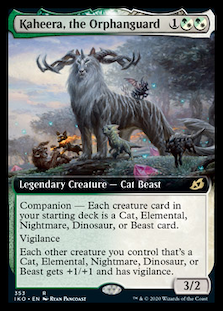 Next is Kaheera, the Orphanguard. While its condition is easily met in any tribal deck centered around Cats, Elementals, Nightmares, Dinosaurs, or Beasts, none of those tribal decks exist in Modern, and I doubt any are on the precipice of a breakthrough. But Kaheera's most interesting aspect lies in what isn't explicitly stated on the card: a deck without any creatures also fulfills its companion condition. In other words, any creatureless deck so inclined can run a Kaheera in the sideboard and run it out at their leisure.
Next is Kaheera, the Orphanguard. While its condition is easily met in any tribal deck centered around Cats, Elementals, Nightmares, Dinosaurs, or Beasts, none of those tribal decks exist in Modern, and I doubt any are on the precipice of a breakthrough. But Kaheera's most interesting aspect lies in what isn't explicitly stated on the card: a deck without any creatures also fulfills its companion condition. In other words, any creatureless deck so inclined can run a Kaheera in the sideboard and run it out at their leisure.
Of course, what such a deck would want to do with a 3/2 is less clear. Cards like Polymorph do exist, which reward players for playing without creatures but nonetheless necessitate one payoff fatty to eventually flip with the spell; cheating in Morophon, the Boundless isn't exactly a sound course of action such a robust format. Still, we could get some sort of card down the line that exploits Kaheera's incidental versatility, so I'd keep an eye on this one.
Yorion, Sky Nomad
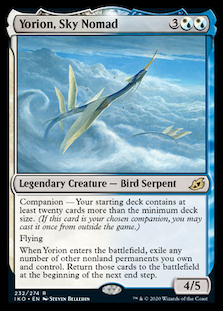 Yorion, Sky Nomad asks a steep price of its players: they are to run 80 or more cards if they want the Bird Serpent as a companion. While many Magic players may balk at the idea, to me, running 80 cards seems like a small price to pay for the effect at hand.
Yorion, Sky Nomad asks a steep price of its players: they are to run 80 or more cards if they want the Bird Serpent as a companion. While many Magic players may balk at the idea, to me, running 80 cards seems like a small price to pay for the effect at hand.
When Yorion enters, it casts Ghostway, a powerful effect that once helmed its own low-tier deck. Ghostway sought to gum up the board with enters-the-battlefield value creatures, and then blink them all to go up on cards, life, or mana. Nowadays, Ghostway-type strategies have all but been supplanted by Eldrazi Displacer mini-synergies and game-ending Collected Company combos. I think a couple major reasons behind the sorcery's never taking off in Modern is that it was unsearchable and took up a precious creature slot in a creatures-matter deck.
Not so with Yorion, which thanks to companion is both is pre-searched and free in terms of card economy. Sure, it's more expensive than Ghostway, but it also leaves behind a 4/5 flying body.
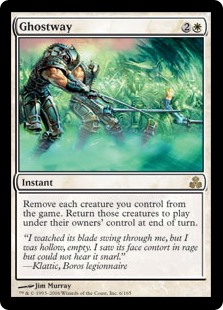 A key break from Ghostway is that Yorion blinks not just creatures, but permanents—including one of Modern's latest breakouts, Arcum's Astrolabe. The artifact, which adds velocity, filters mana, and synergizes with the companion, would be an obvious include, as would similar permanent-grounded cantrips, however rare they may be. Astrolabe even turns on Ice-Fang Coatl, a significant upgrade over the Elvish Reclaimers of Ghostway decks past. Perhaps Oath of Nissa could find a home in such a deck, too.
A key break from Ghostway is that Yorion blinks not just creatures, but permanents—including one of Modern's latest breakouts, Arcum's Astrolabe. The artifact, which adds velocity, filters mana, and synergizes with the companion, would be an obvious include, as would similar permanent-grounded cantrips, however rare they may be. Astrolabe even turns on Ice-Fang Coatl, a significant upgrade over the Elvish Reclaimers of Ghostway decks past. Perhaps Oath of Nissa could find a home in such a deck, too.
As for running 80 cards, I don't think the requirement is the end of the world for the kinds of decks Yorion wants to support. These decks enjoy tremendous redundancy in Modern when it comes to the effects they prefer: mana dorks, value creatures, and the like. I do think Charming Prince would have an important role in the deck for helping get to the right pieces for a given matchup, but other than that, the increased deck size may even open precious slots for added utility. I fully expect Yorion to become a mid-tier contender in Modern post-Ikoria.
Lurrus of the Dream-Den
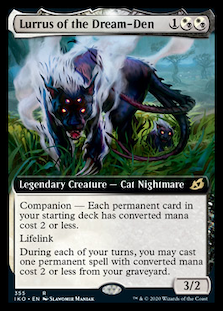 Another companion I think will see immediate play is Lurrus of the Dream-Den. Modern is home to a top-tier deck that almost fulfills its companion requirement: Traverse Shadow. The deck's only permanent exceeding CMC 2 is Liliana of the Veil, generally played as a two-of. So the question becomes: is it worth trimming those two Lilianas to run a Lurrus in the sideboard? Or, put another way, to start every game with access to Lurrus as an additional card in hand?
Another companion I think will see immediate play is Lurrus of the Dream-Den. Modern is home to a top-tier deck that almost fulfills its companion requirement: Traverse Shadow. The deck's only permanent exceeding CMC 2 is Liliana of the Veil, generally played as a two-of. So the question becomes: is it worth trimming those two Lilianas to run a Lurrus in the sideboard? Or, put another way, to start every game with access to Lurrus as an additional card in hand?
I think the answer is a definite yes. While Liliana is great in certain matchups, it's dead weight in others, and since companion says "starting deck," the planeswalker can even be brought in from the sideboard where applicable.
Like Liliana, Lurrus comes down for three mana and begins generating value; while it's a tad lower-impact right away, probably just recurring Mishra's Bauble the turn it resolves, in the mid-game or on subsequent turns it starts bringing back Tarmogoyf and Death's Shadow. These recurs put it far above Liliana in terms of instant impact.
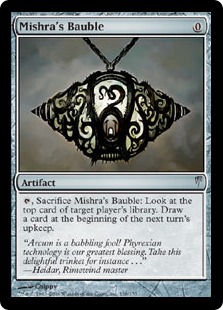 Since Lurrus can be cast from the sideboard, though, it already comes with an extra draw attached—that Liliana would have taken up a slot in the opener or as a turn draw. I think this aspect may be overlooked by some players, but Lurrus indeed provides a burst of value by sheer virtue of the companion mechanic. Let's say it comes down for three mana, recurs Mishra's Bauble, and immediately eats a Lightning Bolt. That's a huge exchange for the Shadow player: Lurrus traded for Bolt, and Bauble put the pilot ahead by a card. But since Lurrus came from the sideboard and not the hand, it was also free in terms of card economy, making the play a plus two... like Treasure Cruise!
Since Lurrus can be cast from the sideboard, though, it already comes with an extra draw attached—that Liliana would have taken up a slot in the opener or as a turn draw. I think this aspect may be overlooked by some players, but Lurrus indeed provides a burst of value by sheer virtue of the companion mechanic. Let's say it comes down for three mana, recurs Mishra's Bauble, and immediately eats a Lightning Bolt. That's a huge exchange for the Shadow player: Lurrus traded for Bolt, and Bauble put the pilot ahead by a card. But since Lurrus came from the sideboard and not the hand, it was also free in terms of card economy, making the play a plus two... like Treasure Cruise!
Finally, Lurrus has applications in other decks, too. Many strategies in Modern meet its requirement. Burn is no stranger to splashing white, and freely recurring Goblin Guide or Grim Lavamancer when the spells start to dwindle is just what the doctor ordered in that deck. Similarly, Bogles tends to run Leyline of Sanctity, but ditching that playset is probably better if it means plucking that Bogle out of the trash after it gets pinched by Inquisition of Kozilek. And Lurrus has lifelink, making it incidental Game 1 protection against faster decks.
Zirda, the Dawnwalker
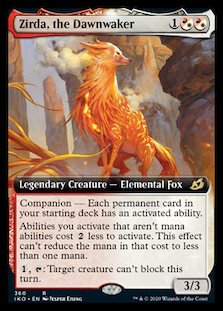 Last on our list is Zirda, the Dawnwaker. Zirda is a walking Training Grounds, but in different colors. And while Training Grounds was annoying for being tough to find, Zirda is always available thanks to companion!
Last on our list is Zirda, the Dawnwaker. Zirda is a walking Training Grounds, but in different colors. And while Training Grounds was annoying for being tough to find, Zirda is always available thanks to companion!
Its condition isn't so hard to meet, either. For starters, any deck of just instants, sorceries, and lands fits the bill. Planeswalkers are also acceptable. So are creatures like Stoneforge Mystic, and artifacts like equipment. Modern decks already exist that can run and cast Zirda as a companion without making a single change, such as Temur Urza.
Granted, in that Urza build, Zirda doesn't do anything but reduce the activation costs of Urza and Engineered Explosives, which are indeed poor payoffs. But it's still a body, and it still has applications in combat. Either way, I imagine it won't be too tricky to build Modern shells that loosely support Zirda enough to get some mileage out of the Elemental Fox, and am open to hearing your combos in the comments.
Never Alone Again
Companions have arrived, and they aren't going anywhere. I have a feeling Modern in 2020 will feel a lot more like Commander, except minus the big playgroups. Either way, while we may be self-isolating, we apparently needn't worry about having no company!




I wonder if the fact that modern burn gets to free-roll Lurrus (assuming you can spare one sideboard slot) will change the decks construction at all. Notably, cards like Seal of Fire or even Hellspark Elemental seem a lot more intriguing when you are guaranteed access to a creature that can re-buy them every game. Sure, both are definitely worse than Lightning Bolt in a vacuum, but being able to potentially get 4, 6, or more damage from only using 1 card if the game goes long seems worth testing.
I do think the odd Vexing Devil build may become more common. But overall, I doubt it. Lurrus is great in that shell even if it goes unchanged. Significantly altering the mainboard to account for Lurrus would mean that Burn expects to hit 3-4 mana in most of its games, which I’m not sure it does. But I don’t doubt that a deck will be built around more explicitly abusing card, as we saw with Unearth.
To be fair, I wasn’t really referring to a whole-scale reimagining of the deck, just more speculating that with the addition of Lurrus, *maybe* the first copy of something like Seal of Fire might be better than the 4th copy of a Rift Bolt.
Ah, I see! Will be exciting to see if that sort of tech catches on. As far as I can tell, Lurrus is a must-include in the deck either way, but I wonder if such smaller concessions to the companion will be made.
Well, a Lurrus Burn list 5-0’d with 4x Seal of Fire!
https://magic.wizards.com/en/articles/archive/mtgo-standings/modern-league-2020-04-21
COERT (5-0)
Creature (14)
4 Eidolon of the Great Revel
4 Goblin Guide
2 Grim Lavamancer
4 Monastery Swiftspear
Sorcery (4)
4 Lava Spike
Instant (18)
4 Boros Charm
4 Lightning Bolt
4 Lightning Helix
4 Searing Blaze
2 Skullcrack
Enchantment (4)
4 Seal of Fire
Land (20)
2 Arid Mesa
2 Bloodstained Mire
1 Fiery Islet
4 Inspiring Vantage
3 Mountain
2 Sacred Foundry
4 Sunbaked Canyon
2 Wooded Foothills
60 Cards
Sideboard (15)
2 Skullcrack
4 Kor Firewalker
1 Lurrus of the Dream Den
3 Path to Exile
3 Smash to Smithereens
2 Tormod’s Crypt
I love the breakdown of the companions, I can’t really comment much other than I don’t see a lifelink creature ever finding a home in a death’s shadow deck…that being said I like the idea of Lurrus recasting Snapcaster Mage so you can recast Kolaghan’s command…even though people probably aren’t doing this much in modern anymore
Well, Shadow does enjoy Collected Brutality in part for the lifegain dimension—it gives the deck a lot more flexibility in race-based matchups like Burn. Having a pre-tutored, always-ready three-mana lifegain creature in a deck that walks a fine line with its life total strikes me as crazy utility for the deck, even if it doesn’t obviously play into its stated Plan A.
As David pointed out in his follow-up piece (https://quietspeculation.com/here-be-questions-ikoria-spoilers-week-2/), though, I had completely forgotten about Street Wraith, which is technically a permanent. While sideboard Lurrus seems far better to me than mainboard Liliana, I doubt it trumps Wraith for the Shadow deck, although perhaps a re-imagining could work. I know some decks I’ve built that splash Shadow as a package (https://quietspeculation.com/introducing-temur-shadow/) have foregone Wraith entirely, and now there’s a no reason to look into that sort of build.
Traverse shadow cant afford losing lili AND street wraith. Or is just people have forgotten traverse shadow still needs street wraith?
I had forgotten! Check out my above comment from four days ago.